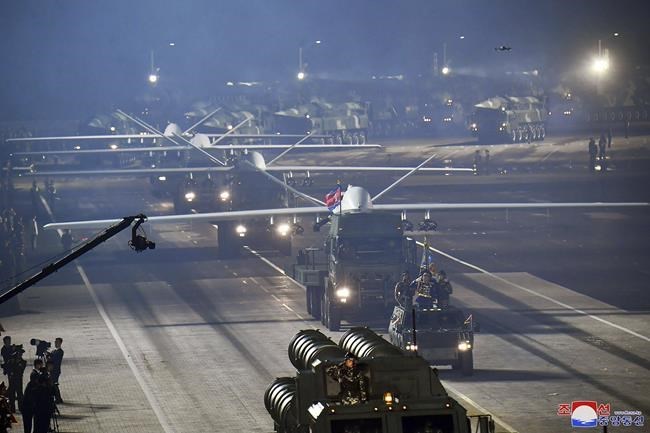
FILE - This photo provided by the North Korean government, shows what it says attack drones during a military parade to mark the 70th anniversary of the armistice that halted fighting in the 1950-53 Korean War, on Kim Il Sung Square in Pyongyang, North Korea, July 27, 2023. South Korea said Thursday it will begin deploying laser weapons systems designed to intercept North Korean drones, which have caused security concerns in the South in recent years. Independent journalists were not given access to cover the event depicted in this image distributed by the North Korean government. The content of this image is as provided and cannot be independently verified. Korean language watermark on image as provided by source reads: "KCNA" which is the abbreviation for Korean Central News Agency. (Korean Central News Agency/Korea News Service via AP, File)
July 11, 2024 - 4:13 AM
SEOUL, South Korea (AP) — South Korea said Thursday it will begin deploying laser weapons systems designed to intercept North Korean drones, which have caused security concerns in the South in recent years.
South Korea’s Defense Acquisition Program Administration said that it will deploy at least one anti-air laser weapons system called “Block-I” by the end of this year and more in coming years.
An agency statement said the “Block-I” system is capable of launching precision attacks on small incoming drones and multi-copters. It said the system, developed by local company Hanwha Aerospace, costs just 2,000 won (about $1.50) per shot.
“We face North Korea on our doorstep and its drones pose present threats to us, so that's why we've been aiming to build and deploy laser weapons soon to cope with them,” an agency official said, requesting anonymity because he wasn’t authorized to speak to media on the issue.
He said that other countries like the United States and Israel are ahead of South Korea in laser weapons technology, but their primary focus has been on higher-powered laser guns that can shoot down incoming ballistic missiles. South Korea also hopes to develop such anti-missile laser weapons, which its defense procurement agency called “a game changer” in future combat environments.
The “Block-I” system is meant to hit circuit boards and other equipment in enemy drones to make them malfunction and crash on the ground. Tests of the weapons system in 2022-2023 were successful and proved its credibility, the official said.
Some experts questioned the technology.
Lee Illwoo, an expert with the Korea Defense Network in South Korea, doubts how effectively South Korea can use its laser weapons since its anti-air radar systems aren't advanced enough to detect North Korean drones well. He said the range of a laser weapon is relatively short, so high-power microwave weapons would be better when enemy drones are flown in large numbers simultaneously.
Jung Chang Wook, head of the Korea Defense Study Forum think tank in Seoul, said South Korea is likely about five years away from acquiring a functioning laser weapon that can shoot down the drones used by North Korea.
North Korea has periodically flown drones across its heavily fortified border with South Korea for several years, in what observers have called tests of South Korean readiness. In December 2022, South Korea accused the North of sending drones across the border for the first time in five years. South Korea fired warning shots and launched fighter jets and helicopters but failed to shoot down any of the drones.
In a key political meeting in December 2023, North Korean leader Kim Jong Un vowed to introduce various types of unmanned combat equipment such as attack drones for 2024. Foreign experts say Kim likely regards drones as a cheap yet effective method to trigger security jitters and an internal divide in South Korea.
Animosities between the two Koreas, split along the world's most heavily fortified border, have deepened in recent months, with North Korea flying trash-carrying balloons toward South Korea in response to South Korean activists floating political leaflets via their own balloons.
News from © The Associated Press, 2024